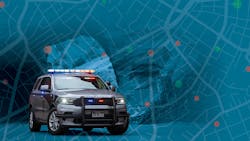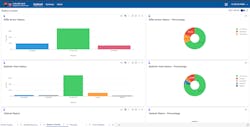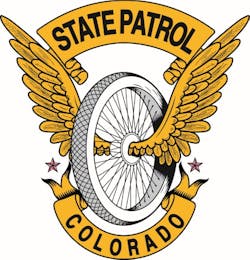When it comes to fleet management, it’s imperative that law enforcement agencies track not only the patrol vehicles themselves, but the gear inside them as well. A new software solution created with the help of the Colorado Department of Public Safety (CDPS) aims to give departments the ability to gather that information efficiently and effectively.
Chief Administrative Officer Kevin Rants and Director of Logistics Services Mike O’Neill, both with CDPS, spoke to OFFICER Magazine about how they worked with Colorado-based NueGov to tailor the software solution to meet their agency’s needs. John Cargile, marketing and business development manager at NueGov, also spoke to OFFICER Magazine about NueGov Public Safety and the company’s goal to streamline asset management for law enforcement agencies.“Our company itself—NueGov—has spawned off from a company called Navjoy; an engineering, consulting and services firm for local municipalities,” says Cargile. “Mostly we have done some work on the eastern seaboard in Florida and in Texas and also in California, but most of our work has been here in Colorado. We’re located right across the street from CDOT’s (Colorado Department of Transportation) headquarters.”
He says that as the company began working on an asset management system for CDOT, CDPS became interested and that initial discussions with Rants’ and O’Neill’s team helped form a beneficial partnership.
More than a patrol car
Rants stresses that law enforcement agencies should view their patrol vehicles as a system. Along with the officers inside, there are devices and gear that must be accounted for. He says that where the vehicle is a system and a trooper is a system in many regards as well. “A firearm has shelf life, a set of body armor has shelf life, a medical kit has a shelf life,” he says, noting that compared to municipal officers, troopers much more. “Tracking things, whether they be a car or a computer that has been taken home, tracking things is tracking things.”
The Colorado Department of Public Safety didn’t have the ability to see those items in a consolidated platform. “The state used a centralized system for fleet management, but it’s an old system designed for your average end user,” he says. “We need to track things like radars, tuning forks associated with the radars, and all of the credentials that a trooper needs in a court case.” Since that system didn’t exist, everything was tracked by spreadsheets, databases and involved a lot of manual input.He says that O’Neill had a vision for what he wanted the system to be. “Mike’s vision was very prescient there, and the ability to not only make it more efficient for his workforce, but to gather that information in a way he and his team needed to be more effective at managing it and seeing things as a system.”
O’Neill says that the ability to track portable breath testers, LiDARs, badges and other items will help greatly improve the efficiency of his team. “I see a big future in this with medium and large departments,” he says. “There is a lot of scalability and growth.”
Addressing needs
For most workplaces, the COVID-19 pandemic flipped the world on its head, leading the Colorado Department of Public Safety to explore a wide world of hybrid and remote work. The need to track assets being sent home with troopers and other employees accelerated the development of the management platform and put their needs into focus.
“There were a couple things I wanted,” says O’Neill. “There are a lot of commercial off-the-shelf type programs that you can do things with. What I’ve seen is that you end up having to use their jargon, their terminology, their processes. What is different with NueGov is that we’re using our nomenclatures, our words, our shared terminology and it really made it our own.” He says that partnership has played a big role in gaining the acceptance of the staff that worked with NueGov to develop the software. “We weren’t falling in on something else that had been developed. It was truly bespoke for us.”
During the Colorado Association of Chiefs of Police Annual Conference in July, Cargile says there was a lot of interest in the platform. “Almost everybody was like ‘We just don’t do this right now in the fashion that you’re offering.’ Obviously, sometimes change is hard and people don’t want to take on the work of implementing a new software solution, but we found that the state, as well as some of these smaller municipalities, have really appreciated it and it’s just making their time expand of what they can do now because they’re not spending so much time just doing paper work.”He says that there are several different levels to the software. “We monitor all of the equipment and all of the assets. Then we also monitor the department as well as the individual officer or employee,” he says. “Somebody would be assigned to that vehicle, and we would have that documented in there. Also, the fleet department will be able to receive alerts when the vehicles need to be serviced. Or tracking any of the equipment that goes into those vehicles and to be able to monitor that to make sure you don’t lose any equipment. All of that is associated into this system.”
Cargile says that many fleet departments store most of this information in systems that are outdated and in some cases are in the process of being phased out. “They’ve been using that for years and now they’ve got to figure out what they can do with this,” he says. “Our timing was great for CDPS, allowing them to be able to take all of that information. We handled the imports for it and input it into the system. Now they can work with it and make the updates and manage all of that.”
Creating the system
Both Rants and O’Neill had worked with Navjoy/NueGov President and CEO Navin Nageli on different projects in the past where he served as a consultant. Both men say that familiarity helped when it came to developing the management solution. “Neither Mike nor I were strangers with Navin. We had worked alongside him in different varying capacities, so I think from that regard, our familiarity with Navin really kind of opened the door to further conversations.”
Some of the requirements for NueGov were identified by ground-level trooper captains and office leaders in the state patrol. O’Neill’s team manages an estimated 10,000-plus serial numbered assets. The system allows CDPS to track the end-of-life cycles for assets that have a shelf life. The system was built with robust reporting so that when the budget process begins, they have the data.
“It was easy to collaborate with Navin’s team to build the structures so it wasn’t only effective for what Mike needed, but it was scalable to what our department would be able to utilize,” says Rants. “We were able to build off of the vision that Mike had with and were really integrate it into a way that we think is going to be beneficial for our department at large as we continue to refine it and then upscale it.”Some of the first meetings took place in mid-2019 and the funding for the project was included into the fiscal year 2021 budget. The development process took about a year and the software went live for CDPS at the beginning of August.
“They built the product specific to our workflows and our requirements,” says Rants. “Changing organizational culture to meet the needs of a piece of software is very challenging and it really leads to failure in our experience. That partnership has been beneficial.”
Rants says although the software has gone live, the development process will continue as it is deployed across the agency. “I think we’re going to use it for a while and then we’re going to tweak it. The next adopter of NueGov is really going to benefit from that work that Mike and his team did and his vision of what he wanted to get out of it.
About the Author
Paul Peluso
Editor
Paul Peluso is the Managing Editor of OFFICER Magazine and has been with the Officer Media Group since 2006. He began as an Associate Editor, writing and editing content for Officer.com. Previously, Paul worked as a reporter for several newspapers in the suburbs of Baltimore, MD.





